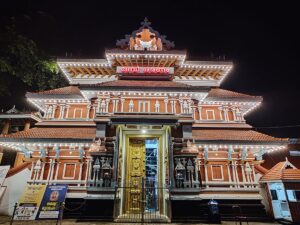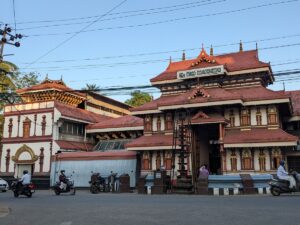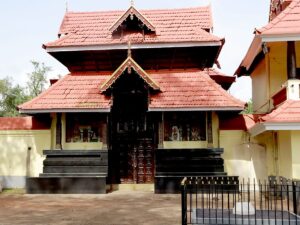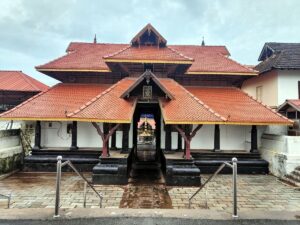Mahabodhi Temple Bodh Gaya
The Mahabodhi Temple Bodh Gaya, also known as the Mahavihara, is an ancient Buddhist temple in Bodh Gaya, Bihar, India. It is one of the holiest sites of Buddhism, marking the location where the Buddha is said to have attained enlightenment. The temple is a UNESCO World Heritage Site.
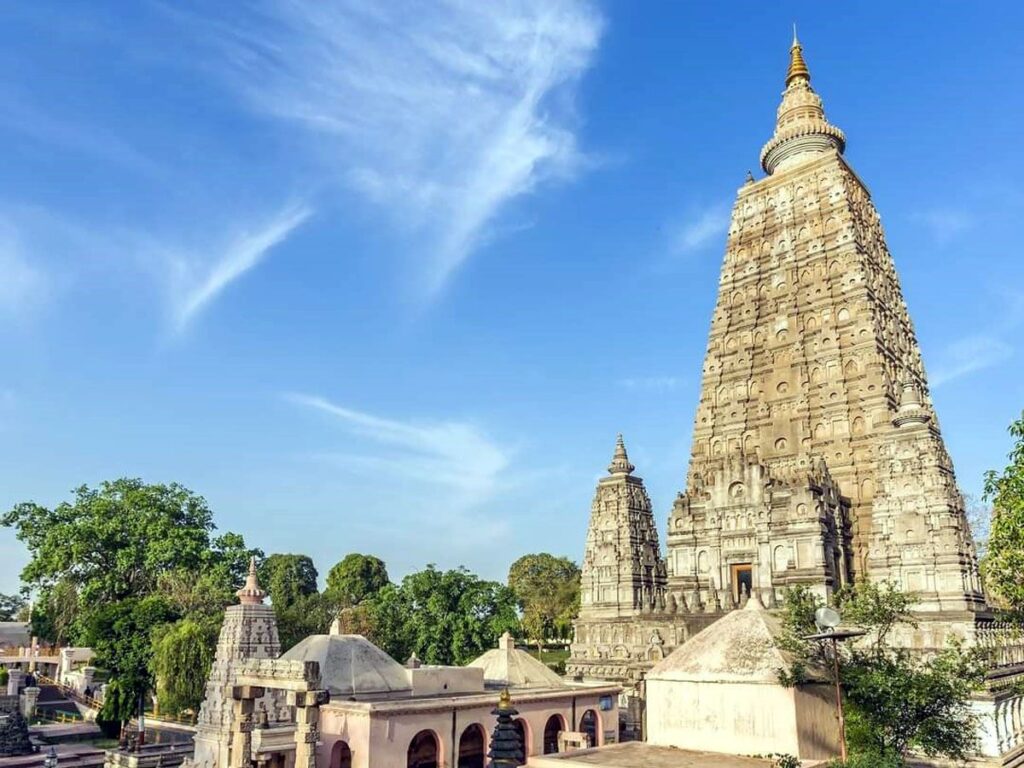
Contents
- 1 History of Mahabodhi Temple Bodh Gaya:
- 2 Legend of Mahabodhi Temple Bodh Gaya:
- 3 Significance of Mahabodhi Temple Bodh Gaya:
- 4 Mahabodhi Temple Architecture:
- 5 Myths of Mahabodhi Temple Bodh Gaya:
- 6 Timing & Rituals for Mahabodhi Temple Bodh Gaya:
- 7 Places to visit near Mahabodhi Temple Bodh Gaya:
- 8 FAQ:
- 9 How to reach Mahabodhi Temple Bodh Gaya:
History of Mahabodhi Temple Bodh Gaya:
Early Beginnings (3rd century BCE):
- Emperor Ashoka, a champion of Buddhism, visited Bodh Gaya around 250 BCE.
- He erected the first temple structure to commemorate the site where Siddhartha Gautama attained enlightenment under the Bodhi tree.
- Ashoka also commissioned the Diamond Throne (Vajrasana), marking the exact spot of the Buddha’s enlightenment. This sacred spot remains a focal point of the temple complex today.
Centuries of Evolution:
- Though Ashoka’s original temple is no longer standing, the present structure dates back to the 5th or 6th century CE, belonging to the Gupta Empire.
- Built entirely of brick, it’s one of the earliest surviving such temples in India and a significant example of Gupta architecture.
A Pilgrimage Destination:
- Throughout history, Bodh Gaya has been a vital pilgrimage site for Buddhists.
- The presence of the Mahabodhi Temple and the sacred Bodhi tree, believed to be a descendant of the original tree, continues to attract pilgrims from around the world.
UNESCO World Heritage Site:
Recognizing its cultural and religious significance, UNESCO inscribed the Mahabodhi Temple Complex as a World Heritage Site in 2002.
Read More>> Konark Sun Temple 13th Century Gem
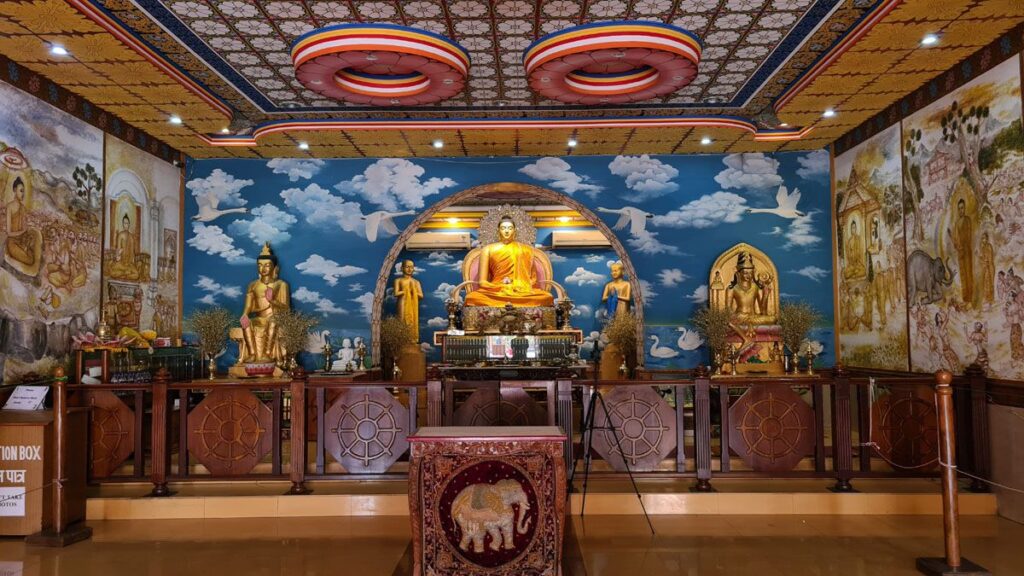
Legend of Mahabodhi Temple Bodh Gaya:
The Disillusioned Prince: According to legend, Siddhartha Gautama, a sheltered prince, became aware of suffering in the world. He left his luxurious life to seek enlightenment, the path to end suffering.
Seeking Enlightenment: Siddhartha wandered and practiced various disciplines. He arrived at Bodhgaya and sat in meditation under a sacred fig tree, later known as the Bodhi Tree.
Attaining Enlightenment: Vowing not to rise until he found the answer to suffering, Siddhartha meditated for days and nights. He finally attained enlightenment under the Bodhi Tree, becoming the Buddha, the “Awakened One.”
The Mahabodhi Temple: Centuries later, Emperor Ashoka, a great supporter of Buddhism, visited Bodhgaya in around 260 BCE. He built the first Mahabodhi Temple to commemorate the Buddha’s enlightenment.
Read More>> Maa Mundeshwari Devi Temple: Unveiling 4th Century Secrets
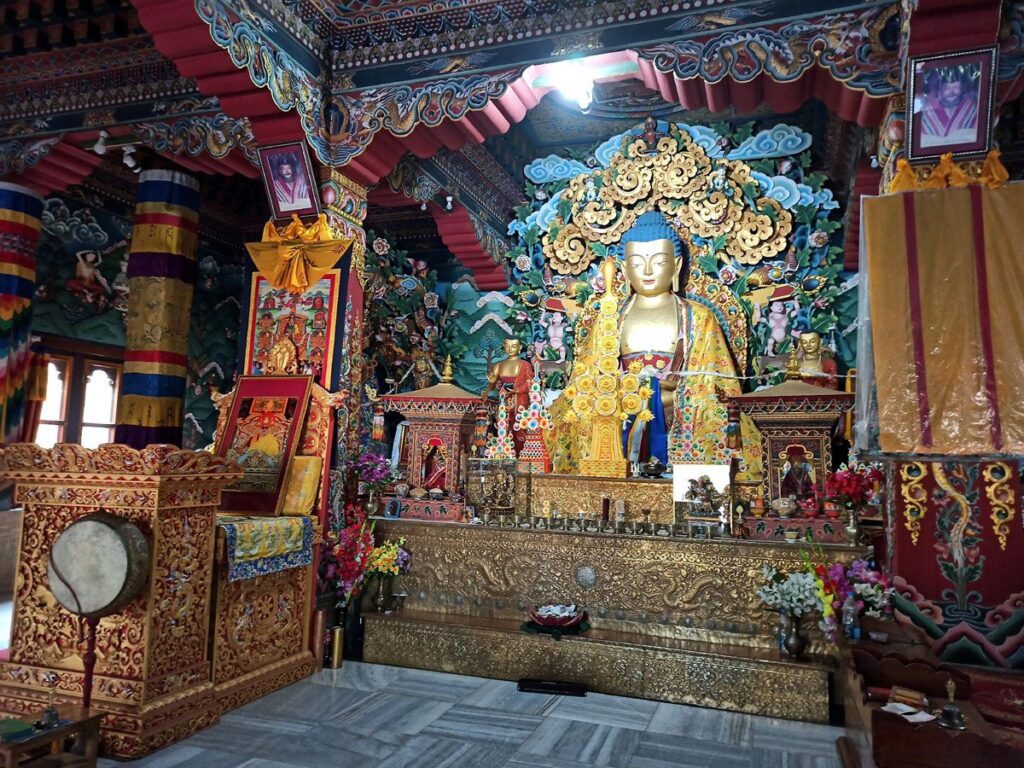
Significance of Mahabodhi Temple Bodh Gaya:
Historical Significance: It’s one of the four most important holy sites in Buddhism, marking the place where Siddhartha Gautama, the historical Buddha, attained enlightenment. This is considered a pivotal moment in Buddhist history.
Ancient Structure: Parts of the site date back to the 3rd century BCE, during the reign of Emperor Ashoka, who is considered one of Buddhism’s most important patrons. The present temple structure itself is one of the oldest brick temples still standing in India, dating from the Gupta period (around 5th or 6th century CE).
Pilgrimage Destination: For over two thousand years, Bodh Gaya has been a major pilgrimage destination for Buddhists from all over the world. They visit to pay homage at the site of the Buddha’s enlightenment and experience the spiritual atmosphere.
Architectural Importance: The Mahabodhi Temple Complex is a UNESCO World Heritage Site and is an excellent example of early Buddhist architecture. The complex includes the main temple, the Bodhi tree, stone railings, and other structures.
Read More>> 10th CE Chakrapani Temple Kumbakonam
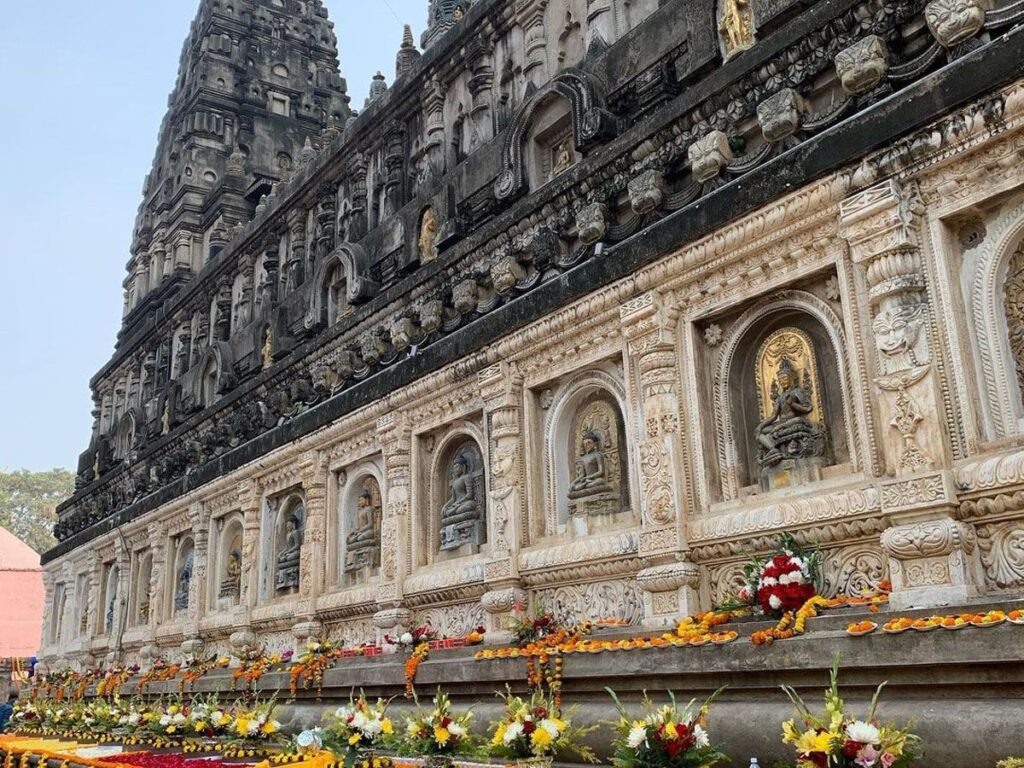
Mahabodhi Temple Architecture:
- Early Architecture: The original Mahabodhi Temple, built by Emperor Ashoka in the 3rd century BCE, was likely a simple brick structure. However, very little remains of this early construction.
- Gupta Period Influence: The current temple complex dates back to the 5th to 6th centuries CE, with significant contributions made during the Gupta period. The temple exhibits classical Indian architectural elements characteristic of this era, such as the use of stone, sculptural ornamentation, and intricate carvings.
- Tower Design: The Mahabodhi Temple features a distinctive tower or shikhara rising above the main sanctum sanctorum. This tower, adorned with multiple tiers and niches, is a prominent feature of North Indian temple architecture.
- Moldings and Carvings: The exterior walls of the temple are adorned with intricate moldings, carvings, and sculptures depicting scenes from the life of the Buddha, Jataka tales, and various deities and celestial beings. These carvings are excellent examples of Gupta period artistry.
- Toranas (Gateway): The entrance to the temple complex is marked by a series of elaborately decorated toranas or gateways. These toranas, which are later additions dating to the 2nd century BCE, feature finely carved panels depicting scenes from the life of the Buddha and various mythical figures.
- Vajrasana (Diamond Throne): At the heart of the temple complex stands the Vajrasana, also known as the Diamond Throne. This stone platform is believed to be the spot where the Buddha attained enlightenment. It is surrounded by a protective railing and is an important focal point for pilgrims.
- Bodhi Tree: Adjacent to the temple stands the sacred Bodhi Tree, a direct descendant of the original tree under which the Buddha attained enlightenment. The tree is a central element of the temple complex and is revered by Buddhists worldwide.
Myths of Mahabodhi Temple Bodh Gaya:
Enlightenment under the Bodhi Tree: The core belief is that Siddhartha Gautama, the founder of Buddhism, attained enlightenment while meditating under a Bodhi tree at this very site. The current Bodhi tree is considered a descendant of the original one.
The Diamond Throne: Beneath the Bodhi Tree lies the Diamond Throne, a stone platform believed to be where the Buddha sat during his meditation.
Stages of Meditation: The Mahabodhi Temple complex itself is said to represent the stages of the Buddha’s meditation. Different areas around the temple correspond to specific weeks of his meditation.
Miraculous Events: Mythology surrounding the Bodhi tree includes miraculous events. One story tells of Queen Tissarakha, jealous of Ashoka’s devotion, trying to destroy the tree. However, the tree miraculously survived.
Sacred Ground: The belief holds that if no Bodhi tree is present, the ground around the site would be devoid of all plant life. Additionally, no creature could traverse this sacred ground.
Read More>> Nambunayaki Amman Temple Rameswaram
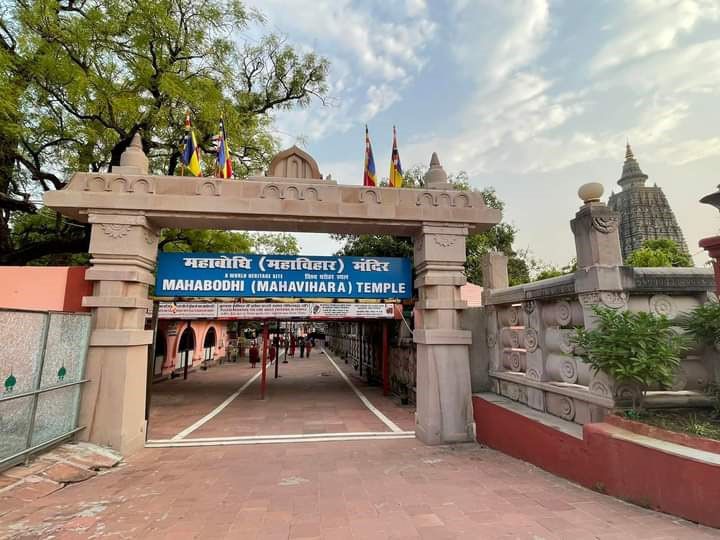
Timing & Rituals for Mahabodhi Temple Bodh Gaya:
Timing for Mahabodhi Temple Bodh Gaya:
The Mahabodhi Temple is open for visitors during the following timings:
Morning: 5:00 AM to 12:00 PM
Evening: 4:00 PM to 9:00 PM
Rituals at Mahabodhi Temple Bodh Gaya:
Pilgrims visiting the Mahabodhi Temple engage in various rituals as a way to pay homage and seek blessings. Here are some of the common rituals:
Offering Puja: This involves offering flowers, incense, and lamps at the Bodhi Tree and the statue of the Buddha
Meditation: Many pilgrims meditate under the Bodhi Tree or around the temple complex, seeking spiritual connection to the place where the Buddha attained enlightenment.
Circumambulation (Pradakshina): Devotees walk around the Mahabodhi stupa and the Bodhi Tree in a clockwise direction as a mark of respect.
Chanting: The rhythmic chanting of Buddhist prayers fills the temple complex, creating a spiritual atmosphere.
Read More>> Andarkuppam Murugan Temple Ponneri
Places to visit near Mahabodhi Temple Bodh Gaya:
- Great Buddha Statue: Located very close to the Mahabodhi Temple, this 25-meter tall statue of Buddha is a must-visit. It’s one of the tallest Buddha statues in India.
- Bodhi Tree: Right next to the Mahabodhi Temple, this ancient fig tree is believed to be the exact spot where Siddhartha Gautama, the Buddha, attained enlightenment.
- Muchalinda Lake: This serene lake is located near the Mahabodhi Temple and provides a peaceful atmosphere for meditation and reflection.
- Bodhgaya Archaeological Museum: Just a short distance from the Mahabodhi Temple, this museum houses a collection of artifacts related to Buddhism and the history of the region.
- Royal Bhutan Monastery: This beautiful monastery is known for its traditional Bhutanese architecture and is a peaceful place to explore.
- Thai Monastery: Another impressive monastery near the Mahabodhi Temple, the Thai Monastery is known for its intricate architecture and peaceful surroundings.
- Tibetan Monastery: This monastery is a center for Tibetan Buddhist studies and offers a glimpse into Tibetan culture and traditions.
- Sujata Kuti: This small temple commemorates Sujata, the woman who offered rice milk to the Buddha before his enlightenment. It’s a tranquil spot for contemplation.
FAQ:
. What is the Mahabodhi Temple? The Mahabodhi Temple is a UNESCO World Heritage Site located in Bodh Gaya, Bihar, India. It is one of the most important Buddhist pilgrimage sites in the world, as it marks the spot where Siddhartha Gautama, the Buddha, attained enlightenment under the Bodhi Tree.
2. What is the significance of the Mahabodhi Temple? The Mahabodhi Temple is significant for Buddhists as it commemorates the Buddha’s enlightenment. It is considered one of the holiest sites in Buddhism and attracts pilgrims from all over the world.
3. When was the Mahabodhi Temple built? The original Mahabodhi Temple was built by Emperor Ashoka in the 3rd century BCE. However, the current temple complex dates back to the 5th to 6th centuries CE and has undergone several renovations and restorations over the centuries.
4. What are the main attractions at the Mahabodhi Temple? The main attractions at the Mahabodhi Temple include the Bodhi Tree, which is believed to be the same tree under which the Buddha attained enlightenment, the Vajrasana or the Diamond Throne, where the Buddha is said to have sat during his meditation, and various shrines, stupas, and sculptures within the temple complex.
5. Is there an entry fee to visit the Mahabodhi Temple? There is no entry fee to visit the Mahabodhi Temple. However, donations for the maintenance and upkeep of the temple are welcome.
6. What are the opening hours of the Mahabodhi Temple? The Mahabodhi Temple is generally open to visitors from sunrise to sunset. However, specific opening hours may vary depending on religious ceremonies and events.
7. Are there any dress code restrictions for visiting the Mahabodhi Temple? While there is no strict dress code, visitors are advised to dress modestly and respectfully when visiting the Mahabodhi Temple. This usually means covering shoulders and knees out of respect for the religious significance of the site.
8. Can photography be done inside the Mahabodhi Temple? Photography is generally allowed inside the Mahabodhi Temple complex, but there may be restrictions in certain areas or during religious ceremonies. It’s always best to ask for permission before taking photographs, especially of people or religious artifacts.
How to reach Mahabodhi Temple Bodh Gaya:
- By Air: The nearest airport to Bodh Gaya is the Gaya Airport (also known as Bodhgaya Airport), which is located around 12 kilometers away from the town. It has regular flights connecting it to major cities like Delhi, Kolkata, and Varanasi. From the airport, you can hire a taxi or take a pre-paid taxi to reach the Mahabodhi Temple.
- By Train: The nearest railway station to Bodh Gaya is Gaya Junction, which is well-connected to major cities across India like Delhi, Kolkata, Mumbai, and Varanasi. From Gaya Junction, you can take a taxi or an auto-rickshaw to reach Bodh Gaya, which is around 12 kilometers away.
- By Road: Bodh Gaya is well-connected by road to major cities in Bihar and neighboring states. You can reach Bodh Gaya by bus or hire a taxi/private car from nearby cities like Patna, Gaya, Varanasi, and Ranchi. The roads are generally in good condition, making for a comfortable journey.








